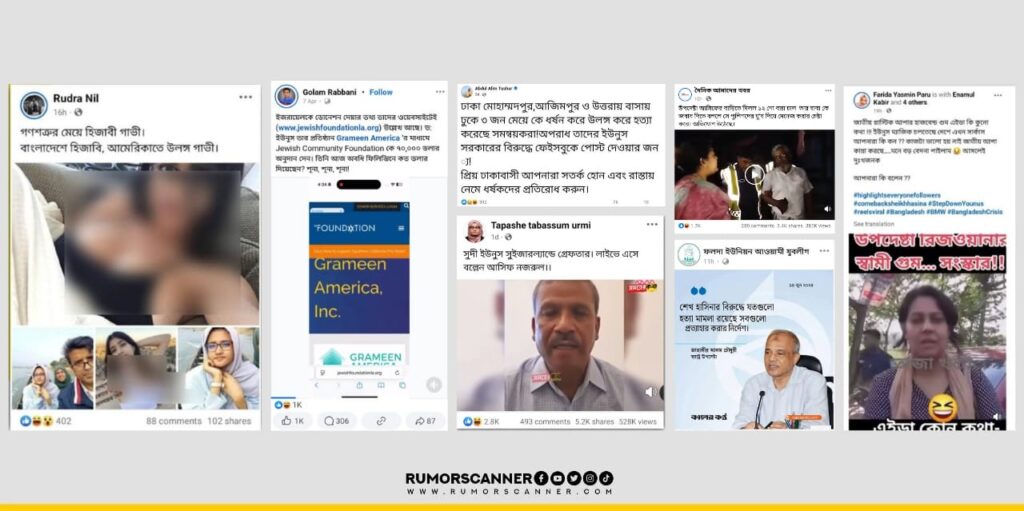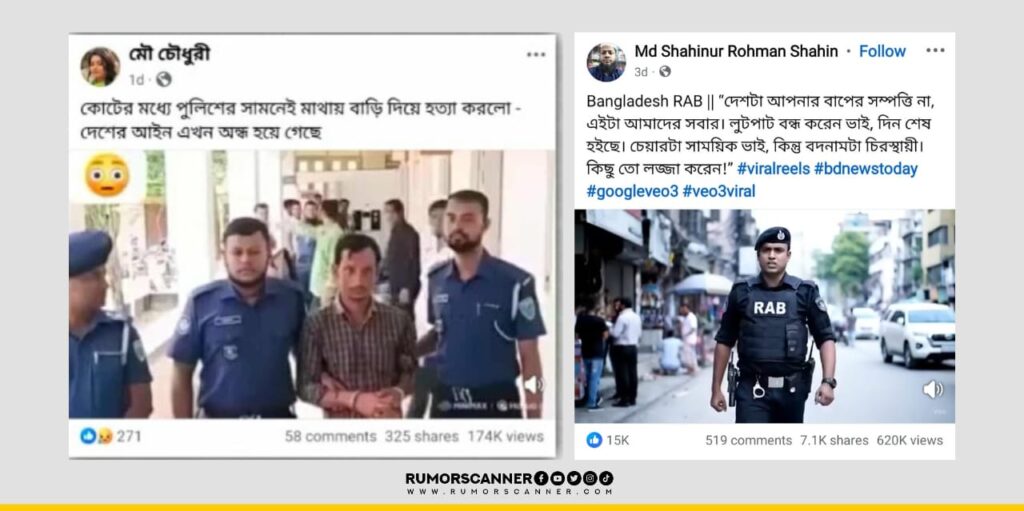- 1795 instances of misinformation identified between January and June.
- Increased by approximately 14% in the second quarter.
- The most misinformation about a single individual is about Dr. Yunus.
- Among political parties, the name of Awami League is associated with the most disinformation.
- As a single issue, the most misinformation revolves around the Iran-Israel conflict.
- 74 instances of misinformation involving the army and 30 involving the police have been identified.
- Communal misinformation and propaganda from Indian media have decreased.
- 308 incidents involving 61 media outlets, with 333 pieces of misinformation identified.
In the first six months of 2025, Rumor Scanner identified 1795 instances of misinformation circulated in Bangladesh, an increase of approximately 30% compared to the same period last year. In the first six months of 2024, Rumor Scanner had identified 1380 instances of misinformation.
The rate of misinformation dissemination in the second quarter of this year increased by approximately 14% compared to the first quarter. This rise in misinformation during the first half of the year is attributed to various political developments, discussions surrounding the upcoming parliamentary elections, and multiple global events.
During this period, Chief Advisor of the Interim Government, Dr. Muhammad Yunus, was the individual most targeted by misinformation. The recent Iran-Israel conflict emerged as the single issue around which the most misinformation was spread. Furthermore, among political parties, the name of Bangladesh Awami League was most frequently associated with misinformation. These findings are based on an analysis of reports published on Rumor Scanner’s website over the past six months.
Flooding of Misinformation on Meta Platforms
Over the last six months, Rumor Scanner identified 1661 instances of misinformation on Facebook and 255 instances on Instagram, both platforms under Meta. On Facebook alone, an average of more than nine pieces of misinformation were circulated daily from January to June. Additionally, 311 instances of misinformation spread on YouTube, 257 on X, and 133 on TikTok. Beyond social media platforms, domestic media outlets also played a role in disseminating misinformation. In the past six months, 90 fact-checks were conducted on Bangladeshi media outlets concerning misinformation, fake images, and videos. Furthermore, during the same period, misinformation related to Bangladesh was propagated in at least 25 incidents by Indian media outlets.
Analyzing the reports published by Rumor Scanner in the first two quarters of the current year, it’s evident that 1125 instances of misinformation containing completely false or fake events were identified during this period. Additionally, 386 items were rated as misleading, and 278 received a distorted rating, while six humorous incidents, initially presented as sarcasm or jokes, were fact-checked due to being claimed as real.
In the process of identifying this misinformation, 709 pieces of information, 336 images, and 750 videos were thoroughly verified.
Misinformation on Political and International Issues Increased in the Second Quarter
In the first quarter, meaning from January to March, 837 instances of misinformation were identified. However, in the subsequent quarter (April to June), this number increased by approximately 14% to 958.
Compared to the first quarter, the rate of misinformation identified on Facebook also increased by approximately 22% in the second quarter. The same trend was observed on Meta’s two other platforms, Instagram and Threads, where the rate of misinformation detection increased by 180% and 100% respectively. Furthermore, the rate of misinformation dissemination on YouTube increased by approximately 51% in the second quarter.
A different picture emerged on X, where the rate of misinformation detection decreased by 41% in the second quarter. However, a nearly equal amount of misinformation was identified on TikTok across both quarters.
Analyzing these quarterly figures reveals that the rate of misinformation detected in the national and religious spheres decreased by approximately 14% and 44% respectively in the second quarter. The opposite trend was observed in political and international issues. While 346 instances of misinformation were identified in the political sphere during the first quarter, this increased by five percent to 364 in the subsequent three months. Similarly, due to various international events, the rate of misinformation detected in this category increased by approximately 312% in the second quarter compared to the first.
The amount of misinformation circulated in the entertainment and literature sector also increased by approximately 87%. In this sphere, actress Sadia Ayman was the victim of the highest amount of misinformation (7 instances) in the last six months.
The reverse trend was seen in education and sports. In these two categories, the amount of misinformation decreased by approximately 29% and 14% respectively. In the sports arena, the highest amount of misinformation (9 instances) across both quarters was identified concerning cricketer Tamim Iqbal.
Awami League and BNP-Jamaat: The Two Sides of Positive and Negative Propaganda
In the first six months of 2025, the name of Bangladesh Awami League appeared most frequently in disinformation circulating within the country’s political arena. This is despite the current interim government’s declaration in May that all activities of the Awami League and its affiliated, associate, and fraternal organizations were prohibited. Rumor Scanner identified 241 instances of disinformation involving the party, its various associate and fraternal organizations, and its leaders and activists over the last six months. Of these, 59 pieces of disinformation specifically implicated the Awami League as a party. Analysis shows that approximately 86% of this disinformation had the potential to create a positive perception of the party. During this period, the highest number of disinformation (85 instances) was circulated concerning the party’s president, Sheikh Hasina, with approximately 80% of these cases presenting her positively.
In the first two quarters of the current year, BNP was the subject of the second highest amount of disinformation (183 instances). Among the 47 pieces of disinformation identified specifically targeting the party, approximately 94% had the potential to create a negative perception of it. During this period, the highest number of disinformation (24 instances) was identified concerning BNP Secretary General Mirza Fakhrul Islam Alamgir, with approximately 87.5% of these cases presenting him negatively. Additionally, 21 instances of disinformation were identified involving BNP Acting Chairman Tarique Rahman. Of these, approximately 52% presented him positively..
In the last six months, Rumor Scanner identified 142 instances of disinformation concerning Bangladesh Jamaat-e-Islami, its affiliated organizations, and its leaders and activists. Among these, 55 pieces of disinformation were circulated directly involving Jamaat as a party. Approximately 93% of these had the potential to create a negative perception of the party. During this period, the party’s Amir, Dr. Shafiqur Rahman, was the victim of the most disinformation (22 instances), with approximately 91% of these cases presenting him negatively.
On February 28th, a new political party named ‘National Citizen Party’ (NCP) was formed with Nahid Islam as its convenor. In the following four months, 86 instances of disinformation were identified concerning this party. Among these, 17 pieces of disinformation were circulated directly involving the NCP as a party, all of which presented the party in a negative light.
During this period, Rumor Scanner identified 11 instances of disinformation targeting the party’s convenor, Nahid Islam, all of which also presented him negatively. However, among NCP activists and leaders, the highest number of disinformation (27 instances) in the last six months was concerning the party’s chief organizer for the southern region, Hasnat Abdullah. Of these 27 instances, all but one presented him negatively.
Interim Government: A Regular Victim of Misinformation
Following the fall of the Awami League government amidst a mass movement, the interim government led by Dr. Muhammad Yunus took office on August 8th of last year. Rumor Scanner identified 135 instances of misinformation circulated about this government last year. During the same period, 110 pieces of misinformation spread concerning Chief Advisor Dr. Yunus. In the first six months of the current year, 69 instances of misinformation targeting this government have been identified, with approximately 91% of these false claims presenting the government negatively. Furthermore, 112 pieces of misinformation about Dr. Yunus were identified in the last six months, with approximately 88% of these cases presenting him negatively. In total, since taking office until June, 204 instances of misinformation have been circulated about the interim government, and 222 instances of misinformation have been spread concerning Dr. Yunus.

Additionally, a total of 68 pieces of misinformation were disseminated over the past six months involving 12 advisors of this government and Press Secretary Shafiqul Alam. Among them, 14 instances of misinformation were identified concerning Dr. Asif Nazrul, and 11 instances involved Jahangir Alam Chowdhury and Asif Mahmud Sajib Bhuiyan.
Law Enforcement & Armed Forces Also Targets of Misinformation
In the first six months of this year, Rumor Scanner found evidence of 114 instances of misinformation targeting armed forces and law enforcement agencies in the country. This represents an increase of approximately 78% compared to the same period last year. Among these, the Bangladesh Army was the subject of the highest number of false claims, with 74 instances detected. This is a significant rise from the 42 pieces of misinformation identified regarding the Army during the same period last year, marking an increase of approximately 76% within a year. Rumor Scanner also identified 25 pieces of misinformation targeting the Army’s current chief, General Waker-Uz-Zaman, in the last six months.
Furthermore, 30 instances of misinformation concerning the Bangladesh Police were detected during this six-month period, an increase of approximately 150% compared to the first half of last year.
Between January and June of this year, Rumor Scanner identified several instances of misinformation targeting key law enforcement and military figures and units. This included one piece of misinformation concerning Inspector General of Police (IGP) Baharul Alam, two regarding DMP Commissioner Sheikh Md. Sajjat Ali, and one about former IGP Md. Moynul Islam. Beyond these individuals, Rumor Scanner also detected four instances of misinformation related to the Bangladesh Air Force, one concerning the Bangladesh Navy, two involving the Rapid Action Battalion (RAB), and three targeting the Border Guard Bangladesh (BGB)
Election Ahead, Signaling a Flow of Disinformation
Bangladesh has begun to experience a strong electoral atmosphere, especially after the government indicated last month that the 13th parliamentary election is likely to take place in the first half of February 2026. Discussions surrounding this election are now ubiquitous.
In this context, Rumor Scanner reported in a research study last month that, in the first five months, BNP was the political party most affected by disinformation. During the same period, the majority of disinformation was disseminated through fake and edited statements attributed to various political parties and high-ranking government officials. Furthermore, the spread of disinformation using edited and fake photocards of media outlets was also notable.
In total, 66 instances of election-related disinformation were identified in the last six months. Of these, 42% were detected in June. This indicates that disinformation on this issue began to increase significantly after a potential election date was suggested.
The conflict between Iran and Israel began on June 13th when Israel launched air and missile strikes on various locations, including important nuclear facilities in Iran. After 12 days of attacks, counter-responses, and threats, news of a ceasefire emerged. This event led to the spread of various types of misinformation across social media and other internet platforms, with old and unrelated videos being regularly circulated. Artificial intelligence technology was also used to create fake videos. Rumor Scanner published 76 fact-checks on this issue. This represents the highest amount of misinformation identified in a single event, both domestically and internationally, during the first six months of this year. Analysis of this misinformation revealed that in approximately 75% of these false claims, Iran was named as the aggressor or portrayed as being in favor of the propaganda. On the other hand, nearly 73% of the fake footage circulated claiming destructive scenes was attributed to Israel. While multiple videos claiming the destruction of important Israeli facilities were circulated during this conflict, no claims of footage specifically mentioning an attack on any important Iranian facility were found.
During a regular meeting of the Advisory Council on May 22nd, Chief Advisor Dr. Muhammad Yunus reportedly expressed his thoughts on resigning. It is understood that during this time, he spoke about various obstacles faced by the government’s initiatives. Following this, discussions on the matter began across social media and other platforms. Simultaneously, Rumor Scanner observed a flow of misinformation centered around this issue. In the four days from May 22nd to May 25th, Rumor Scanner identified at least 16 instances of misinformation surrounding the rumors of Dr. Yunus’s resignation and published fact-checks. This marks the highest amount of misinformation identified in a single event in Bangladesh during the first six months of the current year.
Throughout the first six months of this year, various online platforms in Bangladesh were abuzz with activity across a range of issues. Rumor Scanner identified 393 instances of misinformation related to 34 such issues during this period.
Concerns Regarding VEO 3
As technology continues to advance, so too does the proliferation of fake information disseminated through AI. Over time, AI technology is mastering the creation of increasingly realistic fake videos. The latest discussion point in this technology is Google’s new service, VEO 3. This service enables the creation of highly realistic videos using artificial intelligence. It can generate lifelike videos from text prompts. Videos created with this tool typically bear a ‘Veo’ watermark.
Google launched this service last May. Immediately thereafter, this technology began to be used for propagating misinformation through fake videos. Last month, Rumor Scanner identified at least eight fake videos created using this technology.

In total, 123 instances of misinformation were identified in the first six months of this year, with the use of AI technology observed in these cases. During the same period, 22 deepfake videos were detected.
Reining in Communal Disinformation and Indian Media’s Propaganda
The issue of spreading communal disinformation has been a significant topic of discussion for the past few months in Bangladesh. Rumor Scanner identified 78 instances of such misinformation in the first quarter of this year. However, this number saw a substantial decrease of approximately 64% in the following three months.
Out of the 106 pieces of communal misinformation identified in the last six months, evidence shows that 63 instances (59%) were disseminated through Indian-identified accounts and pages on social media.
Furthermore, from January to June of this year, 38 pieces of misinformation related to 25 incidents concerning Bangladesh were propagated across 31 Indian news outlets. Aaj Tak Bangla tops this list, having disseminated the most misinformation (9 instances).

Misuse of Photocards Continues
For the past few years, media photocards have become a powerful and widely used medium for spreading misinformation in Bangladesh. Misinformation is regularly disseminated using the names, logos, and accompanying elements of media outlets. In the first six months of this year alone, Rumor Scanner identified 333 instances of misinformation across 308 incidents, involving 61 domestic and international news outlets. This misinformation was spread by using the names, logos, headlines, and fake/forged photocards of these media organizations. Among the methods used to propagate false information, the name of mainstream media outlet Jamuna TV was used most frequently (51 times). Janakantha (26 times) ranks second on this list, and Kaler Kantho (25 times) is in third place.
Working Method
This statistic has been published based on reports released on the Rumor Scanner website from January to June 2025. To publish these statistics, data from each report over the past six months was regularly collected and stored in a specific database. Afterward, this data was analyzed. This data was then compared with the first two quarters of the current year and the first six months of last year. Subsequently, it was presented through infographics and written text.
Misinformation spread about political figures and various government officials has been analyzed in this statistic from both positive and negative perspectives. If misinformation attempted to portray a positive image of the relevant individual or party, it was considered positive misinformation. Conversely, if misinformation was likely to harm the image of an individual or party, it was considered negative misinformation. The time, situation, and surrounding circumstances of the misinformation’s propagation were taken into account when making these determinations.






